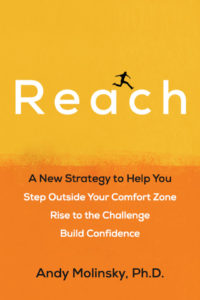You’d like to contribute to discussions at your company, but you can never get a word in edgewise. You know you need to network, but you feel uneasy starting conversations with strangers. You need to start emphasizing your professional accomplishments at work to be noticed, but you feel deeply uncomfortable about tooting your own horn. This list of uncomfortable, but necessary tasks that all of us face could go on and on. And with the constant changes in our lives and in our organizations, it’s only going to get more challenging. We’re crossing national cultures and organizational cultures on a regular basis. We’re changing roles — from worker to manager; from editor to agent; from product developer to CEO. And we’re switching jobs – eleven times on average during our lifetimes.
And of course, the world at large is rapidly changing as well, in deeply uncertain and, in some cases, unsettling ways. Syria’s civil war has created the worst humanitarian crisis in recent memory. According to the UNHCR, one in every 113 people globally is now either an asylum-seeker, internally displaced or a refugee. The United States has a new president with no previous political experience. Allies wonder whether the US will honor its treaties. Citizens wonder what will happen to their jobs, their health care, their futures — and many, for the first time in their lives, are considering political activism. And wherever you stand on the political spectrum, this requires the capacity to stretch outside your comfort zone–to take on new roles and responsibilities, to consider new options and perspectives you may never have before, to stretch in many cases well beyond where we’re comfortable.
Few people enjoy the stress and strain of stretching outside their comfort zones, but, as the saying goes, that is where the magic happens. It’s where we can grow, learn, and develop in ways that expand our horizons beyond what we thought was possible. And with everything that’s happening in our world – from the dizzying pace of technological change to the topsy-turvy world of American politics – personal change isn’t just going to be on the menu in 2017. It’s going to be the main course.
So, here is my bold prediction: 2017 will be the year of the comfort zone, or better yet, the year we take that leap and reach beyond our comfort zones in a major way. As a human race, we’re exceptionally good at creating rationalizations to avoid things we’re afraid of. But my piece of advice is to use your powers of rationalization for a better purpose. Instead of justifying why you shouldn’t take that leap, see if you can convince yourself about why you should. Instead of crafting your job and your life to avoid things you’re afraid of, grit your teeth, take a deep breath, think about the support you have from the people who care about you and take that leap.
And you can begin right away by taking very small steps. Instead of jumping right into speaking at an industry event, sign up for a public speaking class. Instead of speaking up in the boardroom, start by speaking up in smaller meetings with peers to see how it feels. And while you’re at it, see if you can recruit a close friend or colleague to offer advice and encouragement in advance of a challenging situation. You may stumble, but that’s OK. In fact, it’s the only way you’ll learn, especially if you can appreciate that missteps are an inevitable — and in fact essential — part of the learning process.
Don’t get me wrong. It’s not easy to take the leap and act outside your comfort zone. It takes effort, energy, strategy and determination. But with a solid plan in place–– bolstered by commitment and courage–– your results can be extraordinary.
This article was originally published in the LinkedIn Top Voices list, a collection of the must-read writers on the year.
 AVAILABLE JANUARY 2017
AVAILABLE JANUARY 2017
Reach A New Strategy to Help You Step Outside Your Comfort Zone
According to Andy Molinsky, an expert on behavior in the business world, there are five key challenges underlying our avoidance tendencies: authenticity, competence, resentment, likability and morality. Does the new behavior you’re attempting feel authentic to you? Is it the right thing to do? Answering these questions will help identify the “gap” in our behavioral style that we can then bridge by using the three Cs: Clarity, Conviction, and Customization. Perhaps most interesting, Molinsky has discovered that many people who confront what they were avoiding come to realize that they actually enjoy it, and can even be good at it.